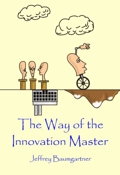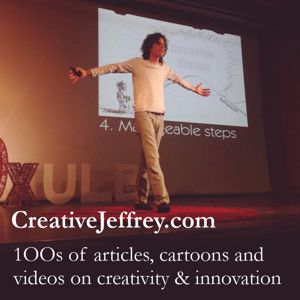Report 103
Your newsletter on applied creativity, imagination, ideas and innovation in business.
Wednesday, 1 December 2010
Issue 177
Hello and welcome to another issue of Report 103, your twice-monthly newsletter on creativity, imagination, ideas and innovation in business.
As always, if you have news about creativity, imagination, ideas, or innovation please feel free to forward it to me for potential inclusion in Report103. Your comments and feedback are also always welcome.
Information on unsubscribing, archives, reprinting articles, etc can be found at the end of this newsletter.
OPEN INNOVATION’S COMMON ISSUES AND POTENTIAL ROADBLOCKS
By Dr. Brian Glassman & Dr. Abram Walton
Note: You can download a PDF version of this article here
To start, open innovation has three different core uses all of which are very effective. Many companies pick one core use for open innovation even though all three are possible simultaneously. The core uses are: generating ideas for new products or services, solving technically vexing problems, or performing co-development of new products or services. The following examples exemplify the employment of these practices.
-
Generating ideas for new products or services. Top management at Proctor & Gamble realized the number of new product ideas needed in order to continue growth at the expected rate placed an untenable burden on their R&D departments. Their solution? Supplement internal R&D with an open innovation model sourcing new product ideas from the entire world.
-
Solve technical problems that are vexing or too complex to be solved internally. The specialty-card maker, Hallmark, saw the future of cards as being more interactive and fun. An internal champion moved to develop musical cards, but Hallmark did not have the internal technical expertise to create or even manufacture these cards. Using an open innovation model Hallmark found a technical partner and worked with them to develop the ideal technology for their low cost audio card series.
-
Co-development of difficult products, services, processes, technologies, etc. Boeing Company uses large-scale partnerships to bring together complex components and systems, from jet engines to cockpit electronics, to create their next generation of jet aircrafts. These partnerships allow Boeing to combine their development resources and capabilities with that of other best in class suppliers, while simultaneously spreading financial burdens and risks among their development partners.
Issues & Potential Roadblocks to Open Innovation
The following section lists the major (as currently identified) downsides and
roadblocks to open innovation. This list is short, but it represents up-to-date
knowledge taken from top books, articles, and leading practitioners.
Internal Buy-In
As with most programs, internal buy-in is necessary for continued success; however,
full internal buy-in is not necessary to start an open innovation program. Dr.
Philip Kotter’s articles on change management discuss creating a guiding
coalition with people passionate about the proposed change. Dr. Kotter recommends
using quick wins to prove the value of the change throughout the company. In
simple applications open innovation can be applied to a single project. Then
after the project is successful, its results can be used as proof to motivate
other managers to join the efforts. Actually, this is exactly what an executive
at Sealed Air used to push open innovation throughout his company.
Establishing Trust with your Open Innovation Partners
In most cases open innovation partners are small entities; for them “large
businesses” are both innately scary and untrustworthy. Companies pursuing
open innovation need to develop a reputation as a “trusted partner”
and be seen as a viable path to market. Staples Corporation is a great example
of how to engage small partners. To reach out to inventor groups, Staples sponsored
events and openly discussed small entities’ intellectual property rights.
To ensure trust was built and maintained, Staples actively managed these new
relationships through open communication.
Companies can increase their trust with the open innovation partners by being honest, avoiding activities that can be construed as leveraging their size and power, and by avoiding overly aggressive negotiations.
Trust is also built through prompt and clear communications. Providing open access to all open innovation officers is a must. Proctor & Gamble worked to establish trust via keeping partners up-to-date on developments; one month without an email or phone call is un-acceptable. Lastly, legal contracts are only brought in after a confirmed understanding of many issues is reached (like IP ownership). Many firms suggest that to encourage innovation and increase the number and quality of ideas generated, that lawyers be excluded from initial ideation conversations.
Intellectual Property
Intellectual property (IP) ownership is one of the most complex problem areas
within open innovation mainly because it can be so central to the future success
of a project. Corporate lawyers know this and always err on the side of full
ownership and limited disclosure for any IP generated with outside partners.
However, open innovation does not mesh with their perspective because open innovation
requires a fair split of IP ownership based on myriad measures, be them: contributed
capital, contributed time and resources, the vital nature of a partner’s
capabilities, etc. Remember, open innovation is a partnership and both parties
must be fairly rewarded for their inputs. Often some degree of IP ownership
or joint ownership is enough to bring a strong partner onboard. There are two
general blocks related to IP and they are the:
a) Corporate lawyer blocks
b) IP category blocks
Corporate Lawyer Blocks
The core beliefs of corporate lawyers conflict with the open innovations partnership
model. A Philips Lighting’s executive suggested not bringing any lawyers
into the agreement process until both parties reach a common oral agreement.
Interestingly, this same executive was a patent agent and drafted his own partnership
agreements. After drafting, his executive friend in the legal department signed
off on the agreements; hence, his close relationship gave him the required buy-in
from the legal department.
IP Category Blocks
The classes a company’s IP fall into greatly affect its ability to conduct
open innovation. IP can easily be broken up into four classes (see Appendix
A for more details). Companies in IP Class 1 deal with products and services
that have little value in patent protection. Consequently these companies can
operate an open innovation program without much concern for IP blocks.
Companies in IP Class 2 are those that can benefit from patents and trade secrets but generally do not require them to operate competitively. These companies should pay some attention to IP but not too much.
Companies in IP Class 3 require IP to compete in their industry; here structured IP contracts are necessary for all types of open innovation. Gathering ideas from the open innovation community becomes very difficult because of IP concerns on both sides. Finally, companies in IP Class 4 are weapons or defense contractors and can not disclose IP or trade secrets due to national security laws. Gathering ideas in this context must be done through structured government programs (STTR & SBIR), and all potential partnerships must be approved by their respective government agencies.
Payment Systems
Open innovation partners are in a sense a supplier, but because they are often
small entities which are frequently untrusting of large companies they often
do not mesh well with large companies’ typical payment processes. The
story below is from an Executive at Sealed Air’s.
‘I was surprised that a huge bottleneck in our open innovation program was our own accounting department! Having to wait 45 days for payment, several of our open innovation partners both refused and were unable to complete work because of their limited funds. I ran around trying to get a check cut to them; finally I used my own department’s accounts to pay them so their work could continue. Luckily, later that year accounting made a special process just for our open innovation partners. This way we could pay within days of their achieved milestones and keep work flowing.’
Communication
Communication is a central capability in finding, evaluating, and working with
open innovation partners. Hence, open innovation requires 1) a set of open communication
channels, 2) people who are communicators and connectors, and 3) an open communications
mindset.
Firstly, an open innovation program requires a public webpage directory of your company’s open innovation officers with their direct phone numbers, emails, and addresses listed freely. Closing contact to your open innovation officers via unlisted phone numbers, layers of secretaries, voice menu systems, and spam blocked emails are the best way to dissuade interested outsiders from contacting you. Further, open innovation web portals, created as a sub-domain, are a smart and easy way to communicate with open innovation partners.
Secondly, an open innovation officer must be a communicator and connector, think of the best networkers in your company who are available at any hour, who love making new connections, and always gets back to you promptly. Do not pick an introverted engineer who has the ‘black hole email address,’ seems like he never answers his phone, or always excuses himself from failures in communication because of his workload. Unfortunately, sometimes these introverts are your best engineers, and except for their lack of networking abilities, would have otherwise been a top choice. Nonetheless, err on the side of choosing a networker versus an all-star engineer, as technical problems can usually be resolved later; whereas, losing potential partners due to lack of communication is very costly.
Finally, an open innovation department must have a mindset based on a deep desire to connect and communicate openly with the outside world. They should also believe that being proper, active, and trustworthy in their communications is a key to their success.
Clear and Stated Agreement Established at the Beginning of the Relationship
Confusion about IP ownership, contributed resources and time, communication
requirements, and rewards can break the bonds of trust between open innovation
partners. Any of these problems can kill the relationship. When working with
your open innovation partners, establish a clear understanding and agreement
on these vital issues. It is reasonable to spend many hours reaching an oral
agreement on these matters before signing a single paper document. According
to the GE Lighting Executive this “upfront work” is well spent as
it creates stronger bonds with the open innovation partners. Short cutting this
process, even for small partners, will invite failure. Repeat confusion and
breaches of trust could result in others labeling your company as a poor or
untrustworthy open innovation partner.
Clear, Descriptive, and Motivating RFP
RFPs (request for proposals) communicate corporate needs to the open innovation
network. RFPs should contain the usual sections and additionally should provide
information about the opportunity areas and background of the project. The problem
statement should be very clear and provide detailed data and information, like
numbers, values, temperatures, pressures, stresses, desired cost levels, and
so on. Well-written RFPs contain as much information as possible without disclosing
vital trade secrets. Do not worry about disclosing opportunity areas or interest
areas, because with this information in-mind open innovation partners can submit
solutions more relevant to such an opportunity. Remember, RFPs that draw the
submission boundaries too tightly miss the opportunity to catch other relevant
solutions and ideas. Finally, make the RFPs easy to read (ex. put a short summary
at the beginning) and make them attractive so your open innovation partners
are motivated to respond. To further motivate potential partners to spend time
on your proposal, consider including information about possible financial rewards
for fulfilling the RFP.
Limiting Participation
Large and prominent companies may receive more responses to an RFP than they
can effectively process. In this case, it may be more work examining the proposals
then actually doing the project itself. For very attractive projects, one can
pre-qualify open innovation partners via short questionnaires or internal screening.
Then, send out the RFPs to this smaller pool of qualified partners. If no subsequent
proposals meet your requirements widen your pre-qualification criteria or remove
them all together.
Unfocused Open Innovation Programs
Open innovation has many possibilities. It is easy to become unfocused and "go
off in any direction." The success of an open innovation program always
benefits from quick wins. The best way to achieve quick wins is to gather needs
from key company figure heads and create a wish list of clear wins. If you can
meet one of these wishes, you will have gained a strong ally in your efforts
to promote the open innovation program.
First, create a wish list for your core areas of use. Companies using open innovation to generate ideas would have a wish list consisting of idea interest areas (like the intersection of advanced antimicrobial metals and air-conditioner technologies) or opportunity areas which would hold great potential; such as new coolants for air conditioners, or a new agent that can be applied to any surface yielding it permanently antimicrobial, such as with COEUS Technologies.
Second, companies using open innovation to solve vexing technical problems should have wish lists organized by technical problems that, if solved, would create high value solutions or allow high value products to be created. This list is organized by highest to lowest value technical problems.
Finally, companies conducting co-development should have wish lists organized with valuable new capabilities or valuable new resources. So for example, in air conditioners the ability to integrate the Wi-Fi into the control of an air conditioner is a valuable new capability.
Unknowns
New research and discoveries on open innovation are constantly emerging; there
is still a lot to learn. For example, researchers are in disagreement as toward
the amount of impact “company culture” can have on open innovation
efforts. Some argue that ‘not invented here syndrome’, being ‘untrusting
of outsiders’ and tight lipped policies against any disclosure block open
innovation, yet others argue those can be quickly changed in-relation to an
open innovation program. Hence, keep searching for new research on knowledge
on open innovation. Nonetheless, be aware of these potentially cultural barriers
within your organization. An awareness and preemptive strategy for incorporating
open innovation practices within an organization can go a long ways towards
success.
If you have any question, you can always email the authors: Brian.Glassman@Gmail.com
or WaltonA@purdue.edu
Appendix A: IP Classes
An important part of open innovation is understanding what class a company’s
IP may fall into:
IP Class 1 – Typically not patentable; too simple to be a trade secret
IP Class 2 – IP can be important but on average it is not, patents and
trade secrets may be appropriated
IP Class 3 – IP is vital for success, should be patented or kept as a
trade secret
IP Class 4 – IP legally can not be leaked due to national security concerns;
kept as only a trade secret
Class 1 typically consists of very common categories of new ideas, such as table cloth designs, footstools, staplers, simple recipes, theories, and books. This class is generalized as being un-patentable due to most ideas in this category having been based on information which is public knowledge. More importantly, companies typically do not seek patents or trade secret protection on this class of IP because of the limited benefits of doing so. In this class, copyrights are more predominate from of protecting the exact designs or artistic work, but like many copyrights, they are easily circumvented.
Class 2 typically consists of companies which do not require patentable inventions or trade secrets to compete, however if they are created they can be valuable. Hence, IP should not be ignored but on average these types of patents do not play a significant role. However, in some cases it may be advantageous to patent or keep something as a trade secret. A company may desire a new combination for processed foods, exterior designs of tables, etc., to be patented or at minimum covered under design patents. A process such as ‘how to create a specific paint pattern on a boat hull’ may also be valuable as a trade secret due to its rarity, more so than its ability to keep competitors from entering the market.
Class 3 consists of patents and trade secrets which are a vital part of success in a particular industry. Industries such as micro-processors, electronics, construction equipment, etc., rely on vital patent portfolios and company trade secrets to maintain their competitive advantages. Gathering ideas/inventions from open innovation partners must be done carefully and in a calculated manner to be effective; while this is one of the hardest classes to gather ideas for, it can still be done effectively.
Class 4 consists of national security-type IP, and pertains mainly to weapons developers and defense contractors who by law can not patent their technologies or disclose their information to outside parties due to strict governmental regulations and associated penalties. All vital information is kept as trade secrets, and thus contractors are forced to abide by strict national non-disclosure laws. External idea generation is mostly done in a government managed system through programs such as STTR or SBIR. Companies can also place their organization in this class if they can make the case that failure to maintain trade secrets or proprietary IP would result in an overall company collapse.
Unfortunately, being in IP class 3 & 4 greatly limits a company’s ability to use open innovation to gather ideas from outside entities (core use number 1). Thus, companies in these classes should look to using open innovation to solve vexing technical problems, or use open innovation to conduct co-development to spread risk and lower investment amounts, or use open innovation build new technical capabilities.
References
1.Open-Market Innovation, Darrell K. Rigby, Chris Zook, Havard Business Review
Article
2.Connect and Develop, Larry Huston, Nabil Sakkab, Harvard Business Review Article
3.The Global Brain, Satish Nambisan, Mohanbir Sawhney, Wharton School Publishing,
2008
4.Open Innovation Researching a New Paradigm, Henry Chesbrough, Wim Vanhaverbeke,
Joel West, Oxford press, 2006
5.Open Innovation , Henry Chesbrough 2003, HBR press
6.Interviews conducted at the Front End of Innovation Conference 2010, Dr. Brian Glassman
ABOUT THE AUTHORS
Brian Glassman, Ph.D., graduated from the College of Technology at Purdue University specializing in Innovation Management and Technology Commercialization. He received his B.S. and M.S. degrees in Mechanical Engineering and a second M.S. in Engineering Management from Duke University. His research, consulting, and scholarly interests continue to explore the many facets of Innovation Management and Technology Commercialization; and he is a passionately-driven entrepreneur. Brian is very open to questions and can be reached at Brian.Glassman@Gmail.com
Abram Walton, Ph.D. is an Assistant Professor at Purdue University, Anderson, in Technology Leadership and Innovation. He earned his Ph.D. in Product Lifecycle Management; engineering management and strategic technology road mapping – Purdue University; a M.S. in Technology and Strategic Human Resource Management - Purdue University; and a B.S. in Management Information Systems - Northwest Nazarene University. Dr. Walton instructs business, leadership, and industrial technology courses, and consults on strategic technology acquisitions and development. He also conducts research in Product Lifecycle Management, Lean, Human Resource and Organizational Development, Educational Technology, Systems Thinking, Leadership, and Change Management. He has authored and presented papers and book chapters on Product Lifecycle Management, Metrics Dash-boarding, Educational Technology, Managerial Authenticity, Climate Change, International Leadership, and Engineering Management. Abram is very open to questions and can be reached at WaltonA@Purdue.edu
THE WAY OF THE INNOVATION MASTER
A New Book by Jeffrey Baumgartner
My new book, The Way of the Innovation Master, is out today and can be ordered via our web site on http://www.creativejeffrey.com/books/. The book will be available at Amazon, on-line retailers and bookshops over the next few weeks. An eBook version will be available very soon.
I am very excited! Let me tell you about the book.
The Way of the Innovation Master comprises three parallel, interspersed and interrelated cycles. The first is the journey of Jane, a newly appointed CEO of an ailing company that had once been an innovative start up. Her Journey is from her company’s corporate headquarters to the Temple of Ideas, a little known innovation haven atop a mountain somewhere in Southeast Asia. Along the way, she meets a useful guide (with whom you will be familiar) and a number of other interesting characters.
The second cycle is a series of dialogues between two old-school company presidents as they grapple with the issues of adopting an innovation process. Their dialogue is half modelled on the dialogue of gods in ancient Greek drama and half modelled on the fiction of P.G. Wodehouse.
The third cycle is a series of lessons, a number of which are based on articles that started life in this journal. The lessons build up a plan, model and method for implementing an innovation process in a company like yours.
The three cycles are all interrelated. For instance, Jane’s experiences in her journey up the mountain foreshadow the lessons to be learned a few pages further on.
The aim of the book is to give you the knowledge you need in order to become an Innovation Master and lead your firm on a path to success through innovation. However, it is not the usual, dry business book. Rather it aims to be an enjoyable read which, I like to think, is rich in the creativity I espouse in this eJournal, on www.jpb.com and in my life.
The Way of the Innovation Master is available in paperback and eBook formats. Visit http://www.creativejeffrey.com/books for more information, excerpts and links to purchase.
WWW.JPB.COM MAKEOVER
We’ve redesigned the www.jpb.com web site to make it more manageable. Now some 15 years old, www.jpb.com holds an unwieldy collection of web information, images and more. In order to help you find what you want, we have now divided the site into three main areas: business products, people products and the read and learn area. This allows business managers seeking idea management, consulting or training services to access quickly and easily the information they require. People looking for personal creativity products and services will be directed to a separate part of the web site focusing on their needs. And those people who want to read and learn can go to the bit of the web site that includes Report 103.
Initial feedback has been positive. But I would love to know what you think. Your feedback on the new design is welcome!
JENNI INNOVATION PROCESS MANAGEMENT (IPM) SOFTWARE
Whether your company is looking for business model innovation ideas, suggestions for incremental improvements or new product concepts, Jenni innovation process management software provides you with a collaborative platform for generating ideas and evaluating them for business viability.
Moreover, unlike many idea management products, Jenni provides you with total control over ideation focus, participation and evaluation criteria. Indeed, Jenni provides you with the best idea evaluation tool set available on the planet!
For more information about Jenni, visit http://www.creativejeffrey.com/jenni/index.php or reply to this newsletter and I will put you in touch with someone who can discuss your innovation needs.
ARCHIVES
You can find this and every issue of Report 103 ever written at our archives on http://www.creativejeffrey.com/report103/index.php
Happy thinking!
Jeffrey Baumgartner
---------------------------------------------------
Report 103 is a complimentary eJournal from Bwiti bvba of Belgium (a jpb.com company: http://www.creativejeffrey.com). Archives and subscription information can be found at http://www.creativejeffrey.com/report103/
Report 103 is edited by Jeffrey Baumgartner and is published on a monthly basis.
You may forward this copy of Report 103 to anyone, provided you forward it in its entirety and do not edit it in any way. If you wish to reprint only a part of Report 103, please contact Jeffrey Baumgartner.
Contributions and press releases are welcome. Please contact Jeffrey in the first instance.





